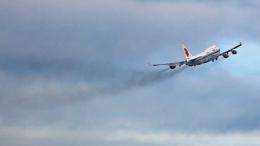Winds of change for pollution sensing

(Phys.org) -- The Great Smog of London is often upheld as a time when pollution reached appalling levels: over a four-day period in December 1952, the capital came to a standstill, cars were abandoned, airports closed and over 4,000 people died due to respiratory or cardiovascular problems. But what might come as some surprise is that roughly the same number of people died as a result of pollution in London in 2008.
The pollutants may have changed – then it was smoke and sulphur dioxide from coal fires, now it’s principally ozone, nitrogen dioxide and fine particulate matter, mostly from vehicular emissions – but, according to a report by the House of Commons Environmental Audit Committee, 30,000 deaths in the UK were linked to air pollution in 2008, and life expectancy could be reduced by as much as nine years in the worst-affected areas.
With calls for the government to meet European Union standards on air pollution, the provision of accurate, real-time monitoring of air quality is crucial to understanding the factors that influence pollutant concentrations. A new study led by the University of Cambridge has begun testing instruments that could revolutionise not just pollution sensing but also relating actual exposure to medical impacts.
The small, portable, low-cost instruments contain a series of sensors that measure six gases, volatile organic compounds and airborne particulates. “Some of the sensors were developed for use indoors as gas alarms but working with project partner Alphasense we’ve been able to push the sensitivity a thousand-fold for use in an urban environment,” explained the project leader, Professor Rod Jones, from the Department of Chemistry. “Our portable instruments, capable of taking measurements in a wide range of environments, will complement the UK’s network of pollution monitors which operate at fixed sites across the country.”
The project, which has been funded by the Natural Environment Research Council, follows a proof-of-concept study carried out in Cambridge in 2009. Sensors deployed around the city monitored the levels of carbon monoxide and nitrogen oxides in the air, and GPRS functionality allowed the data to be transmitted via the mobile phone network back to a central server from where the data are accessible via web interfaces. Using visualisation tools such as Google Earth, the researchers were able to monitor pollution levels on a street by street basis.
An improved version of these devices is now being deployed at 60 locations around Heathrow Airport. The units, which are wireless and battery powered, also contain a miniature counter that measures tens of thousands of airborne particles per second developed by the University of Hertfordshire with support from the University of Manchester.
“Over 12 months, the sensors will gather data from around the airport to correlate pollution with the factors that cause it,” explained Dr. Iq Mead, who is responsible for the sensor node design, construction and deployment. “We couldn’t do this without the support of the British Airport Authority and British Airways, who are providing a record of the movement of planes and their specific thrust levels.” In addition, researchers at Imperial College London are providing valuable input on modelling transport and deployment of the units, with the National Physical Laboratory assisting with aspects of the network calibration.
The study will generate a complex dataset, and one of the challenges has been to create software that correlates pollutants with the movement of cars and planes, and with the time, location and weather. The software design, which has been led by Mark Hayes, Director of the Cambridge eScience Centre, will also enable modelling of future changes, such as what effect the building of a third runway at Heathrow could have on pollution levels.
A contract with Geotech will result in manufacture of a version of the system that will be starting trials later this year. The first systems will be lamppost-mounted, measuring gases wirelessly for up two years. Particulate monitoring and a portable version are planned for later phases of commercial development. The team is also working with Cambridge Environmental Research Consultants – a world-leading urban air-quality modelling group – who will use the unprecedented level of data created by the study to test their models of air quality.
Moreover, as Jones explained, the system could be the beginning of a new means of pollution monitoring for health: “These sensors could eventually be small enough to pin to the lapel and cheap enough to be used in parts of the world that can’t afford expensive equipment. We’ll be able to relate actual exposure to particular pollution events to medical impacts. In a sense this is a disruptive technology. It’s going to change the way that people monitor individual exposure.”
Provided by University of Cambridge













